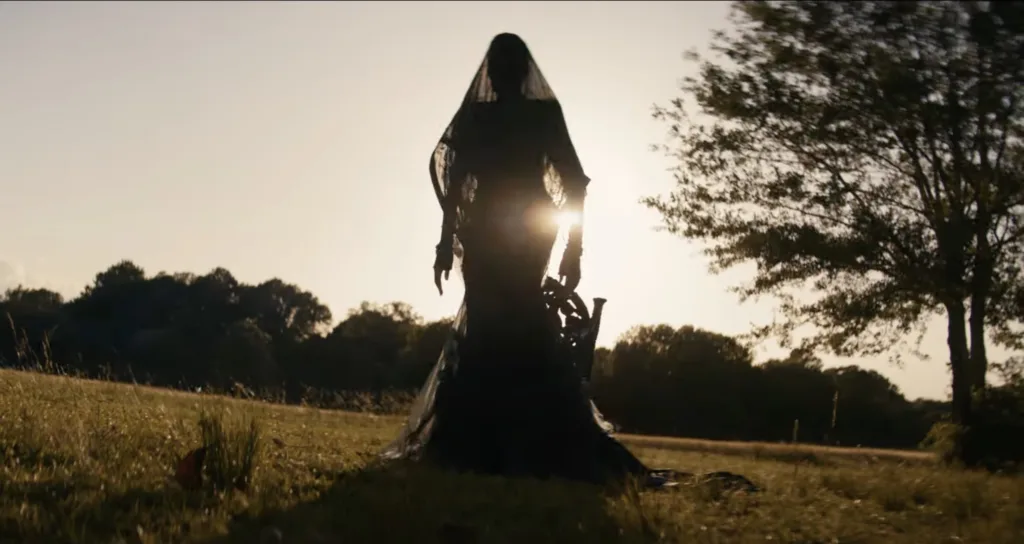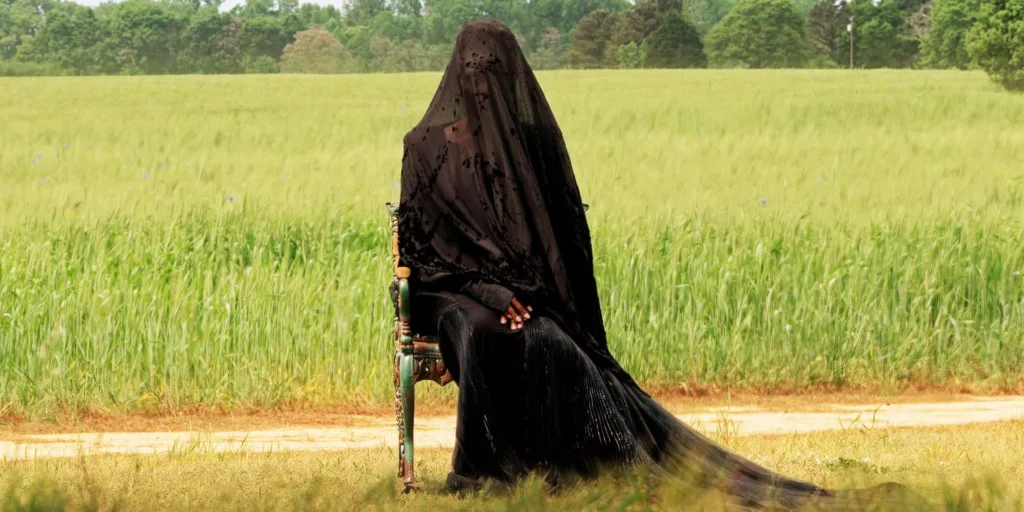In a forlorn farmhouse tucked away in rural Georgia, the film unfolds like a somber elegy—a narrative where psychological unease meets spectral intrusion. The image of a solitary, shrouded figure in the yard serves as a quiet incantation, summoning reflections on grief and the inescapable specter of solitude. The farmhouse, marred by neglect and stripped of modern conveniences, becomes a stage where every shadow and empty corridor whispers the remnants of a once vibrant life.
The story centers on Ramona, a bereft widow whose existence has been unmoored by loss. With her household in disarray and her own inner turmoil palpable, she struggles amid the silence that only deepens with the mysterious visitor’s subtle approach. Her teenage son and young daughter, each bearing their own silent burdens, complete a family portrait marked by isolation and fractured reality.
The film opts for a dialogue between visceral dread and contemplative introspection, presenting scenes that invite viewers to ponder the nature of despair and the elusive presence of hope. As the spectral figure slowly makes her presence felt, the viewer is drawn into a reflection on the quiet, profound disturbances that ripple through the human soul.
Evolving Shadows: Unraveling the Narrative Fabric
The narrative unfolds in a slow cascade, beginning with a desolate silence that mirrors a family caught in the throes of sorrow. In the early hours, the weight of Ramona’s solitude sets the stage—a quiet mourning punctuated by moments of strained domesticity.
As the day wears on, a spectral presence begins to emerge, its arrival both subtle and jarring, unsettling the already fragile order of the household. The progression of events traces a path from the intimate despair of isolated grief to an unsettling crescendo, marked by the sudden, almost imperceptible, intrusion of an otherworldly visitor.
A single moment—the first sighting of the veiled figure—acts as a fulcrum in the film’s unfolding drama. This encounter shatters the routine of mundane hardship and opens a portal where memories of a tragic past and the harsh reality of present loss intermingle. Intermittent flashbacks, recalling the fatal accident and the dissolution of familiar comforts, serve as cryptic punctuation in the narrative, each glimpse a fragment of a disjointed whole. Mirrors and shadows repeat their silent refrains, their reflections suggesting decay and a hidden truth that remains just out of reach.
The film arranges its scenes in a non-linear fashion, interspersing disquieting recollections with the immediate tension of the haunted present. This arrangement leaves a series of questions suspended in the air: What is the true nature of the spectral interloper?
Does she embody a forgotten guilt, a spectral sorrow, or something else entirely? The screenplay’s refusal to confine its mysteries to tidy explanations invites an engagement that is as unsettling as it is thought-provoking, leaving viewers to wander amid flickering images and echoing doubts.
Fractured Echoes: Portraits of Sorrow and Resilience
Ramona emerges as a figure ensnared in the throes of loss—a mother whose days are shadowed by the absence of her departed partner and the burden of responsibilities too vast for one soul. Her expressions oscillate between quiet resignation and bursts of unrestrained emotion, a chiaroscuro of vulnerability and fierce determination. One senses in her every strained glance and hesitant step an internal conflict where guilt and sorrow mingle with the desire to shield her children from a desolate reality.
Her children, one burdened with premature maturity and the other observing with a silent, unspoken wisdom, cast reflections of a broken family portrait. The older child, compelled by necessity, assumes roles that strain the delicate fabric of youth, while the younger offers a glance of innocent perception that underscores the family’s disintegration. Their interactions evoke a poignant meditation on the human condition—a delicate balance between duty and despair, instinct and uncertainty.
The spectral woman, an enigmatic presence that punctuates their daily monotony, appears with a quiet but disquieting air. Her rare utterance, a simple pronouncement of a destined day, leaves an impression that is both unsettling and loaded with unspoken meaning. The way her presence disrupts the familial routine invites speculation on whether she symbolizes a fragment of repressed anguish or an external echo of the inner turmoil that haunts Ramona.
Minor figures in the narrative, though sparing in appearance, contribute subtle strokes to this somber canvas, their fleeting appearances deepening the overall sense of isolation. The interplay among the cast imbues the scene with a charged atmosphere—a delicate, yet unpredictable, balance between the forces of fragility and defiance.
Shadows of Remorse: A Study in Symbols and Emotions
The film speaks in a language of loss and isolation, its narrative steeped in the weight of despair and the mystery of the unknown. Its story, much like a solitary house left to the mercy of time, portrays grief as a persistent, haunting echo.
The cluttered corridors of the farmhouse mirror the fractured mind of those burdened by sorrow, each room a testament to memories too heavy to bear. In one particularly striking scene, the scattered remnants of a once orderly home stand as silent witnesses to a past marred by tragedy—a visual allegory of disarray and desolation.
Ramona’s silent suffering is rendered palpable through scenes that exude a persistent, almost tangible despair. Her internal torment, marked by a ceaseless oscillation between numbness and bursts of raw emotion, brings forth a narrative that questions the very nature of human vulnerability.
The film poses a silent inquiry: Can the scars of the past ever truly fade, or do they remain etched into the fabric of our beings? The spectral figure that haunts the yard offers no simple answers. Instead, her presence acts as an ever-present reminder of unresolved guilt and unspoken sorrow—a shadow that intrudes upon the daily struggles of a family trying to survive its own disintegration.
The absence of modern comforts, the void of external communication, and the isolated landscape all serve as potent symbols of abandonment. These elements intensify the inner conflicts of the characters, each isolated moment echoing the silence of forgotten hopes.
The interplay of reflections in broken glass and the shifting silhouettes in dim light evoke questions about the dual nature of existence—where the physical and metaphysical converge in an uncertain dance. The film’s score, with its intermittent bursts of sound and long periods of near-inaudible murmurs, amplifies the sense of desolation that pervades every frame, leaving the audience to ponder the ineffable truths hidden within the dark recesses of the human condition.
Flickering Silhouettes: The Language of Light and Decay
The visual narrative unfolds through expansive shots that capture the solitude of a weathered farmhouse set amid the vast openness of rural Georgia. Each frame serves as a silent witness to isolation; the wide vistas echo the internal desolation of its inhabitants.
Light and shadow interlace in a dance that renders everyday moments into unsettling canvases. A lone beam piercing through a cracked window, or the interplay of soft daylight with creeping darkness, transforms the mundane into a spectral painting that unsettles and enchants in equal measure.
Jaume Collet-Serra directs with a careful hand, orchestrating each scene so that tension rises organically. His choices in framing—the way the spectral figure is placed against the backdrop of a dilapidated homestead, or the slow, measured movement that lends weight to every moment—suggest a meditation on the nature of fear and loss. There is a deliberate, almost ritualistic pace that allows the viewer to absorb each visual note as it resonates in the space between narrative beats.
The setting itself assumes a role as central as any character. The decrepit farmhouse, with its sparse interiors and neglected remnants—a scattering of laundry, bare furnishings, and a rusted car set aside like a relic—whispers tales of a bygone era. Its overgrown yard and crumbling walls provide a stage where decay and despair converge, instilling a sense of unease that permeates the entire film.
The production favors practical techniques over digital spectacle, grounding the supernatural elements in tangible textures. Each effect feels handcrafted, lending an authentic quality to the portrayal of otherworldly occurrences. The score, a composition of distant echoes and intermittent string harmonies, interjects moments of near-silence with sudden bursts of sound, amplifying the visual narrative. In these moments, the absence of noise speaks as powerfully as any dialogue, leaving the audience suspended between clarity and obscurity.
Whispered Cadences: The Pulse of a Haunted Narrative
The screenplay speaks softly through images and spare dialogue, with phrases like “Today’s the day” punctuating moments of stillness. Its economy of words serves as a quiet beacon amid a story saturated with loss and eerie happenings. The sparse lines carry weight, each one a measured beat that holds the narrative in a suspended state, inviting the viewer to interpret the silences as much as the spoken words.
The pace is measured and deliberate, a slow unfolding that mirrors the characters’ inner battles. Each scene unfolds like a muted soliloquy, the gradual tension building across long, reflective intervals before erupting in moments of striking intensity. At times, the tempo stumbles, as the narrative rhythm becomes uneven—a cadence that mirrors the unpredictable nature of human despair. Such moments of disjointed timing serve not as flaws but as echoes of the chaotic inner lives of those who have been scarred by tragedy.
Emotional undercurrents flow quietly through each frame. Ramona’s struggle with loss and isolation is rendered with a careful balance, inviting viewers to witness the burden of sorrow that defines her existence. The ambiguity of the spectral presence creates a space where uncertainty reigns; it is unclear whether the haunting figure represents an external phantom or a manifestation of buried guilt.
The fusion of visual imagery, resonant sounds, and deliberate dialogue crafts an atmosphere that blurs the line between the psychological and the otherworldly. Each element contributes to a rich, if sometimes uneven, tapestry of fear and introspection, leaving the audience to carry forward questions that stir in the quiet moments after the film fades to black.
Full Credits
Director: Jaume Collet-Serra
Writer: Sam Stefanak
Producers and Executive Producers: Jason Blum, Stephanie Allain, Jaume Collet-Serra, Danielle Deadwyler, Gabrielle Ebron, James Moran
Lead Actors: Danielle Deadwyler as Ramona, Okwui Okpokwasili as The Woman, Russell Hornsby as David
Supporting Cast: Peyton Jackson as Taylor, Estella Kahiha as Annie
Director of Photography (Cinematographer): Pawel Pogorzelski
Editors: Timothy Alverson, Krisztian Majdik
Composer: Lorne Balfe
The Review
The Woman in the Yard
A haunting exploration of loss and isolation, this film casts a spectral shadow over familiar tropes, provoking quiet reflection on human vulnerability. Its visuals and measured pacing evoke a lingering dread, while character struggles and an enigmatic presence invite personal interpretation. The uneven narrative tempo occasionally disrupts immersion, yet the film remains a meditative inquiry into sorrow and the human condition. Its evocative imagery and deliberate silences enrich the experience, marking it as a poignant, if occasionally disjointed, cinematic statement.
PROS
- Thoughtful exploration of grief and isolation
- Evocative visual style and atmospheric cinematography
- Strong central performance by Danielle Deadwyler
- Deliberate pacing that effectively builds tension
- Minimalistic dialogue that deepens thematic resonance
CONS
- Uneven narrative pacing may disrupt immersion
- Occasional ambiguity might leave some viewers uncertain
- Limited exposition challenges those seeking clarity
- Some narrative elements feel derivative


















































